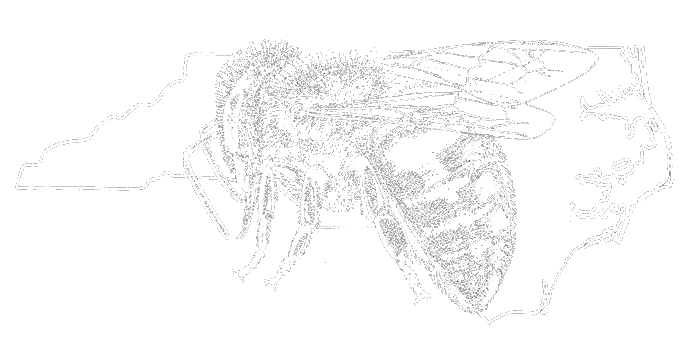General Guidelines
- The labels of the Certified Honey Producer Program must be affixed only to containers of honey that are known to be produced in North Carolina.
- The participant must be an active beekeeper unless otherwise approved by the Certified Honey Producer Program (CHPP).
- The participant must not engage in deceptive marketing or advertising and must label honey in accordance with federal, state and CHPP guidelines.
- A container labeled as honey must not contain any additives or flavoring.
- Creamed honey may bear the ‘certified’ and ‘discover the goodness’ labels and must be made from honey produced in North Carolina.
- The ‘Discover the Goodness of North Carolina Honey’ label should be affixed to every container or should be displayed prominently where certified honey is sold.
- The ‘Certified’ or ‘Discover the Goodness’ labels must not be used to advertise or otherwise promote the sale of honey produced outside of North Carolina.
- Hives must not be fed sugar syrup or corn syrup during periods of honey flow.
- Honey should not have a moisture content exceeding 18.6%.
- Mite treatments must be used according to manufacturer labeling.
- The honey must not be pasteurized or heated beyond 110 degrees Fahrenheit.
- The honey must be sold in its natural state and can be filtered to allow for removal of honeybee debris and wax particles.
- The honey must not be ultra-filtered or otherwise processed to remove pollen.
- Sanitary and healthy extraction facilities and procedures must be observed as described by the NCDA&CS.
Government Honey Labeling Regulations
Unlike other food products, there are no state or federal standards of identity for honey that can be enforced under the state or federal Food, Drug and Cosmetic Acts. Honey can be found offered for sale in containers labeled with various amounts of information; some of which is pertinent and some of which is simply marketing. Exactly what labeling information is required for a container of honey sometimes creates confusion
Federal Honey Labeling Regulations
The minimum labeling requirements for honey are outlined and regulated by the federal Fair Packaging and Labeling Act (FPLA), enacted in 1967, which directed the Federal Trade Commission and the Food and Drug Administration (FDA) to issue regulations requiring that all ‘consumer commodities’ be labeled to disclose net contents, identity of commodity, and name and place of business of the product’s manufacturer, packer, or distributor. Net weight should be shown on the label in both pounds/ounces and grams.
State Honey Labeling Regulations
In North Carolina, the guidelines for the labeling of honey conform to the requirements of the federal FPLA. In a memorandum of understanding by and between the Food and Drug Protection Division and the Plant Industry Division of the North Carolina Department of Agriculture & Consumer Services dated August 10, 1984, the labeling requirements are set forth and paraphrased below. Products which are sold or represented to be honey must be labeled as follows:
- The common or usual name ‘honey’ must appear on the label. A floral source such as sourwood, clover, etc., may be part of the name provided the product contains a significant amount of pollen from that flower.
- The name, address and zip code of the manufacturer, packer or distributor must also appear on the label.
- A declaration of net contents must appear in the lower thirty percent of the label panel expressed as weight such as “Net wt. 30 oz. (1 lb. 14 oz.)”.
Regarding honey that is to be sold at Farmers Markets operated by the North Carolina Department of Agriculture and Consumer Services, effective June 1, 2012, a permit is required to sell honey labeled as ‘sourwood’ or ‘North Carolina Honey’ at state owned Farmers Markets. No permit is required to sell other types of honey. At a state supported Farmer’s Market, the guidelines read: “Sellers who are found to be selling honey in violation of these Guidelines will be denied permission to sell ‘sourwood’ or ‘North Carolina’ honey on the Market and may also be subject to loss of privilege to sell on the Market.”
The NCDA&CS Food and Drug Protection Division is responsible for any enforcement of its regulations. The NCDA&CS has responsibility to enforce the state-owned Farmers Market regulations for sourwood and North Carolina honey.
NCSBA Certified Honey Producer Program Honey Labeling Guidelines
- Participants must observe the labeling requirements set forth by the appropriate federal (FDA) and state (NCDA&CS) agencies.
- The floral source of the honey should be accurately represented on the label. Unless honey is produced from a known predominate source of nectar, such as clary sage, sourwood, gall berry or has been tested to determine to the nectar source, then the honey should not be labeled as to be from one predominate source but, instead, should be labeled as wildflower honey, spring honey, fall honey or other inclusive categories.
- The term organic honey should not be used to describe CHPP certified honey.
- The name, address (street & city), and zip code of the beekeeper producing the honey must appear on the label.
- Net Weight must be given on the lower 1/3 of the label in both pounds/ounces and grams, following these formulas: 1 oz = 28.35 g; 1 lb = 16 oz = 453.6 g. Example: Net wt. 16 oz (453.6 g).
- To avoid infant botulism, the CHPP recommends that labels also include a cautionary statement about not feeding honey to infants less than one year old, as advised by the American Academy of Pediatrics (see aappublications.org/news/2018/11/19/honey111918).

